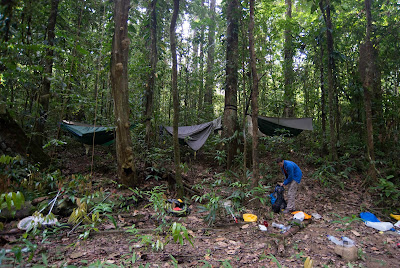 |
| The authors, taking a break from meta-analyzing to do some fieldwork in the Bahamas. |
One detail that often gets left out of the advice to write a meta-analysis as a first-year student: actually performing a meta-analysis is a ton of work! Scanning thousands of papers for suitability, inputting hundreds of estimates of selection, and scouring bibliographies for candidate studies took much, much longer than I anticipated. But, the advice also proved to be true: I read widely4, learned a ton, and we (eventually) turned the meta-analysis into a publication, now available online at Molecular Ecology. So, what exactly did we learn? The paper has all the nitty-gritty details, but here are some of the highlights:
- It's an exciting time to be studying natural selection at the genetic level! We were really surprised at the breadth of research: biologists calculate selection coefficients in many different ways, in a wide variety of organisms, using many different types of data. DNA sequencing is more accessible than ever before, and this has made it much easier to incorporate genomics into field experiments. Most of our estimates of selection came from two such studies5, and we believe that genomics-enabled field experiments of adaptation will lead to a lot of new discoveries about how evolution proceeds. But researchers estimated selection in all sorts of other ways. My favorite off-the-beaten-path example: Robinson et al. 2012, who used Bayesian epidemiological modeling to quantify selection at the PRNP gene (which influences susceptibility to prion diseases) in white-tailed deer.
- Given how many different ways there are to estimate selection, we were surprised to find that selection coefficients are rarely estimated. We searched thousands of plausible papers, many of which inferred natural selection at the genetic level, but a relatively small percentage of papers (~3.5%) actually quantified selection. There are, of course, many reasons why this might be the case (and we speculate on some of them in the paper), but, whatever the cause, we encourage biologists to quantify selection more often! As our paper hopefully shows, selection coefficients can help us answer some very interesting questions, and more data will lead to better conclusions.
- We found that the distribution of selection coefficients was roughly exponential, with most estimates of selection being quite weak, but a few being quite strong (there were many estimates of s > 0.5!). This distribution relates to all sorts of theoretical questions (what are the dynamics of adaptive walks to a fitness optimum? What is the extent of local adaptation? How are positive and negative selection related?) and practical issues (when trying to measure selection, what values of s are possible? In Bayesian models, what sort of priors should we put on selection coefficients?). The distribution of phenotypic selection coefficients is also roughly exponential. This similarity led to some novel theoretical work, done in collaboration with Dr. Sally Otto at UBC, about how genetic architecture may (or may not) influence how these distributions are related.

The distribution of the 3416 estimates of s included in our
quantitative analyses.
I could go on, but check out the paper (http://onlinelibrary.wiley.com/doi/10.1111/mec.13559/full) for a much more thorough discussion of these issues and many others, including thoughts on how selection varies through time, the prevalence of overdominant selection, and the best ways to report and interpret selection coefficients in manuscripts.
2. Another good reason, at least in my case: I had to write a meta-analysis as a term paper for the evolutionary ecology course I was taking.
3. Before that, studies of selection at the genetic level were limited to Mendelian traits/alleles, such as melanistic alleles in the peppered moth, where genotype could be reliably inferred from phenotype.
4. When was the last time you read a paper from the Russian Journal of Human Genetics?
5. Anderson et al. 2014, on local adaptation in a species of mustard, and Gompert et al. 2014, on selection in Timema stick insects.
Related papers:
Anderson JT, Lee C-R, Mitchell-Olds T (2014) Strong selection genome-wide enhances fitness trade-offs across environments and episodes of selection. Evolution, 68, 16-31.
Gompert Z, Comeault AA, Farkas TE et al. (2014) Experimental evidence for ecological selection on genome variation in the wild. Ecology Letters, 17, 369-379.
Hereford J, Hansen TF, Houle D (2004) Comparing strength of directional selection: how strong is strong? Evolution, 58, 2133-2143.
Kingsolver JG, Hoekstra HE, Hoekstra JM et al. (2001) The strength of phenotypic selection in natural populations. The American Naturalist, 157, 245-261.
Lande R, Arnold SJ (1983) The measurement of selection on correlated characters. Evolution, 37, 1210-1226.
Rieseberg LH, Widmer A, Arntz AM, Burke JM (2002) Directional selection is the primary cause of phenotypic diversification. Proceedings of the National Academy of Sciences, 99, 12242-12245.
Robinson SJ, Samuel MD, Johnson CJ, Adams M, McKenzie DI (2012) Emerging prion disease drives host selection in a wildlife population. Ecological Applications, 22, 1050-1059.
Siepielski AM, DiBattista JD, Evans JA, Carlson SM (2011) Differences in the temporal dynamics of phenotypic selection among fitness components in the wild. Proceedings of the Royal Society B: Biological Sciences, 278, 1572-1580.
Siepielski AM, Gotanda KM, Morrissey MB, et al. (2013) The spatial patterns of directional phenotypic selection. Ecology Letters, 16, 1382-1392.
Thurman TJ, Barrett RDH (2016) The genetic consequences of selection in natural populations. Molecular Ecology, 25, 1429-1488.









